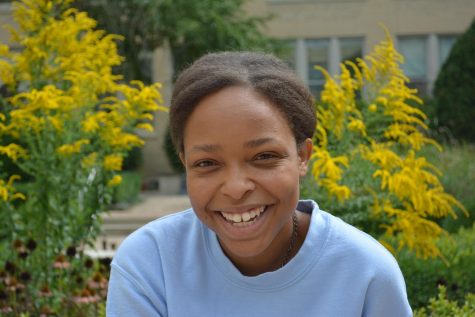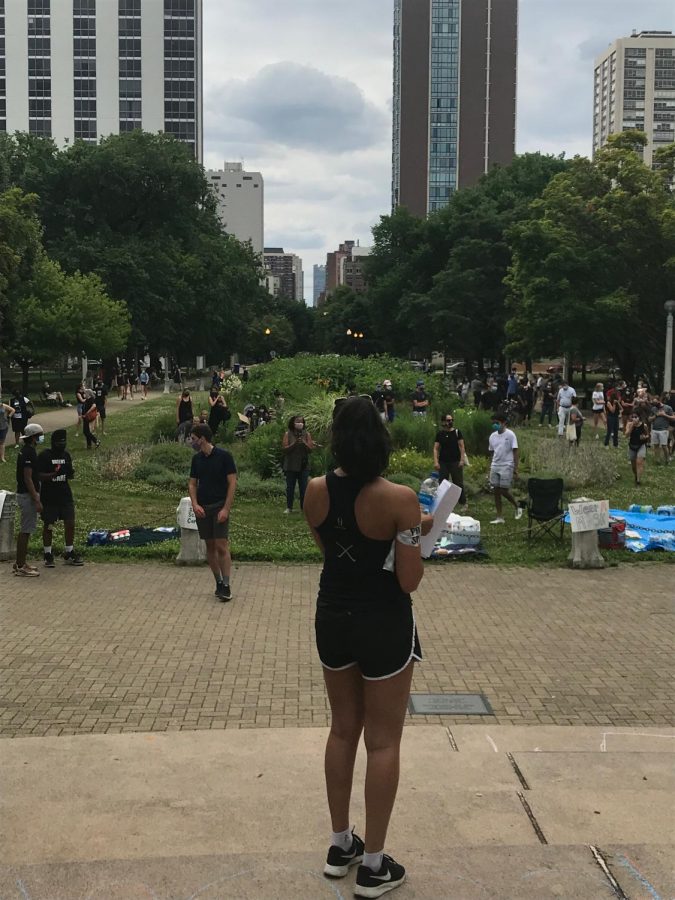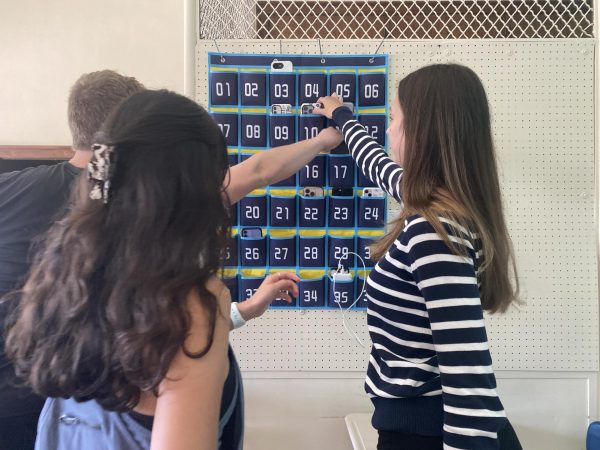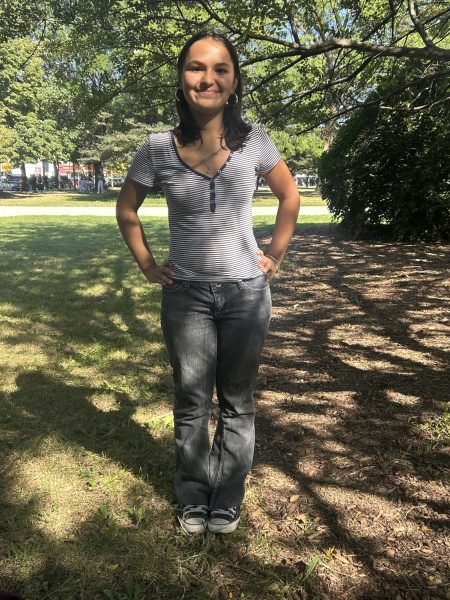The Latin School of Chicago has taken strides toward educational equality. Here are two students behind the effort.
An organizer of the student-led Latin School of Chicago protest against racism speaks to a crowd gathered in Lincoln Park, July 11, 2020.
A light drizzle fell over Lincoln Park as protesters from the Latin School of Chicago gathered to “promote and insist on the reconstruction of the system that is Latin, and the establishment of an equitable and unbiased experience for all.”
It was July 11, about noon, and the protesters stood beneath the concrete eyes of an Abraham Lincoln statue, as if they were straddling two moments of renewed calls for racial equality — one in 1861 with the start of the Civil War, and the other at the end of May after the police killing of George Floyd.
Indeed, George Floyd’s death caused not only widespread protests, but the creation of tell-all Instagram accounts geared toward exposing racism and bigotry at educational institutions, as well as a new wave of youth activism, including at Lane.
According to Latin protest organizer Kazi Stanton-Thomas, the Survivors of Latin Instagram page, whose purpose is to “shed light on the horrific experiences of Latin’s BIPOC and LGBTQ+ students, alumni, parents, and faculty,” inspired the protest.
“[Survivors of Latin] started posting about these things and we really just thought — we all knew that Latin was problematic, but we didn’t know how far it went back,” said Stanton-Thomas, Class of 2022. “After that started, it just fueled how upset we were.”
Soon after, Stanton-Thomas and their peers formed the group Demanding Accountability and organized the July 11 protest. With demands including more diverse curricula, an impeachment process for student officials, the hiring of more POC faculty members, and timely investigations into misconduct, the protest itself featured a panoply of student and alumni speakers.
Among these speakers was 2020 alumna Keiara Stallworth. During her speech, which concluded the protest, Stallworth tearfully recalled being bullied by her peers for speaking African American Vernacular English, and expressed her wishes for the school’s future.
“So many things have happened during my time at Latin that I just never would imagine that would happen. And I’m thankful for the people who are a part of my life that made it easier at Latin. But there needs to be some kind of change, y’all,” she said. “I’m standing up here today because there’s people who I care about who still have to go to Latin. And yes, I’ve graduated, but I’m forever attached to Latin, and I hope that today sparks some kind of change.”
It seems that the protest did indeed cause change — in a July 15 email interview with The Warrior, the Latin School of Chicago Upper School Director Kirk Greer addressed some of the protesters’ demands.
“We are certainly examining the sequence of our curriculum, both in academic classes and supplemental program[s] like through our advisories, to make sure all students encounter a multiplicity of voices and perspectives,” Greer said. He added that the school has introduced a new process for reporting bias, and is “eager to work with students” in order to institute more change.
And on Sept. 4, according to Latin’s newspaper, The Forum, the administration held a meeting in which they announced that “affinity groups will now meet twice a cycle, and conversations surrounding DEI [Diversity, Equity, and Inclusion] will continue in advisory with the help of student government, the Student Diversity and Equity Committee, and the Identity Coalition for Latin.” The school administration also debuted the new “Incidents of Bias Report” form, which students can use to report “aggression against an individual or group’s identity.”
According to The Forum, the Upper School Diversity Coordinator Brandon Woods specified that the report’s purpose was not to punish, but rather to create a system that helps students “achieve the expectations that we have clearly laid out today.”
The faces behind the protest
“It was the scariest thing I’ve ever done,” Keiara Stallworth told The Warrior about her July 11 speech, but she says she felt an obligation to help change her alma mater for the better. This is why, at the end of June, she announced via Instagram video that she would write an open letter to Latin to demonstrate that “everybody is looking for a change in the Latin community.”
She told The Warrior, “The amount of frustration that was happening at that time — I was tired of sitting around and not doing anything. I needed something to do, somewhere to put my frustration. I needed something tangible.
“I figured, why not make this video and hear what people say and try to make some change, because at the end of the day, I know it’s not going to affect me as I’m not a student anymore, but like I’ve said countless times, … there’s going to be future POC, Black people, BIPOC people, who are going to walk through Latin’s halls, and I want it to be better for them than it was for me.”
Stanton-Thomas echoed this sentiment in an interview with The Warrior.
“That’s really the start of my activism and that’s what drives me to this day — I have these traumas, but also, I feel like I don’t want anyone else to experience these traumas. Because you know, it shouldn’t be like this,” they said.
This is why they energetically agreed to lead the protest when, late one July night, their friend approached them with the idea.
“One of my friends hit me up one day — it was really late at night — and she said, ‘I’m gonna pull a group of people together and it’s probably going to be to develop a protest at Latin. Do you want to join?’ And me, I’m like, ‘That’s not even a question — of course I want to join,’” Stanton-Thomas recalled.
Stanton-Thomas says they are pleased with the progress Latin has made in the wake of the protests, but believes there is more work to be done.
“My hope is that Latin can learn and really put in the motions to create an environment that’s not just meant for the cisgenered straight White man,” they said. “It should just be an environment for everyone.”
Since the summer, they’ve also taken a more active role in their school’s diversity initiatives.
“I’ve been building an identity coalition at my school that basically brings all of the identity groups, affinities and clubs together so that we can talk about our problems and figure out a course of action together,” they said. “So in the spirit of intersectionality in activism, we don’t have to stand alone by our identity. I’m also going to be one of the co-heads of my Gender, Sexuality and Minority affinity group.”
As for Stallworth, freshman year at Emory University has occupied much of her time, but she plans to send the letter over her winter break. She says that the protest was a sort of catharsis, a “big emotional relief” that came with students and alumni sharing their stories of discrimination and ostracization.
“And I think that’s kind of what happened on whatever stage or the steps, is that I was like ‘Damn, it’s been rough for me and it’s been rough for everybody sitting here on these steps and it’s been rough for a bunch of people who aren’t here and it’s going to be rough for a bunch of people in the future,’” she said.
And in light of recent changes at her alma mater, she says she is proud of herself and her classmates.
“It’s amazing to see what a bunch of kids can do,” Stallworth said, “and once we put our mind to something, how much we could accomplish.”
Your donations directly fund the Lane Tech student journalism program—covering essential costs like website hosting and technology not supported by our school or district. Your generosity empowers our student reporters to investigate, write, and publish impactful stories that matter to our school community.
This website is more than a publishing platform—it's an archive, a research tool, and a source of truth. Every dollar helps us preserve and grow this resource so future students can learn from and build on the work being done today.
Thank you for supporting the next generation of journalists at Lane Tech College Prep!

Naturally having harnessed the wisdom that comes with age, Finley, now a senior in her third year with The Champion (formerly The Warrior), spends her...




